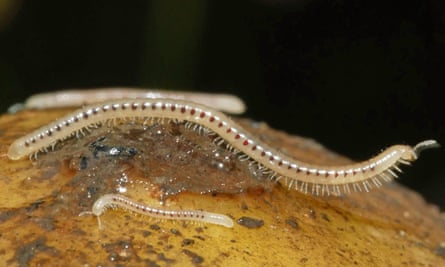Digging the vegetable garden, I uncovered a potato, overlooked in an earlier harvest. I wondered if it was fit for the pot, then noticed the small hole in the side. A long column of pale, centimetre-long, thread-like animals marched out into the sunlight and fell to the ground.
I captured a few of the army that had hollowed out the potato. The first question, in my mental identification key to soil animals, was how many legs per segment? Easy: two, so they must be millipedes, not centipedes. Second question: total number of legs? Almost impossible to count, because they were never still. Scores of limbs rose and fell, in a rippling, undulating wave – mesmerising choreography that travelled the length of the animals’ bodies, in an endless cycle.

Count the segments and multiply by two, perhaps? That wouldn’t help much. I had 15 of these restless creatures, of various sizes, in the collecting vial. Some were just a few millimetres long. As millipedes grow, they add more segments, like adding extra carriages to the end of a train. I couldn’t be certain that any was a fully mature adult, but the longest seemed to have about 40 pairs of legs. When I shook the captives, a thousand feet stampeded.
Fortunately, this species has a convenient identification feature. They were spotted snake millipedes, Blaniulus guttulatus, given away by red spots on the flanks of most of their segments: ozopores, stink glands, reputed to repel predators.

Now it was time to let them go. They loitered on the surface briefly, then disappeared into a crevice, to resume their subterranean lives. I imagined them, head tucked down, forcing their way through gaps in freshly dug soil, driven forward by a relentless rugby scrum of 40 pairs of short, powerful legs.
Back to the digging, with the aroma of fresh, damp soil and mouldering leaves rising from every turn of the garden fork. Nearby, a hungry blackbird hurled fallen leaves aside, foraging for whatever morsels lay beneath. Among the scents of autumn, millipedes’ stink glands might not protect them from its attention but, in the deep, dark caverns of the soil, repulsive body odour might be the key to survival.

Comments (…)
Sign in or create your Guardian account to join the discussion